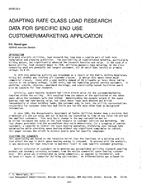Description
With most electric utilities, load research has long been a routine part of both rate formulation and planning activities. The availability of sophisticated metering, particularly billing meters, has significantly advanced the research function and value. In the case of a Boston utility, load research began in 1978, utilizing magnetic tape metering, in the class containing what are generally the largest customers, all of which take service at primary voltage, 13.8 KV.
In 1979 this metering activity was broadened as a result of the Public Utility Regulatory Policy Act (PURPA) and involved all customer classes. In Boston this meant three major commercial classes: those with a peak monthly demand of 20 kilowatts or less; those taking service at the primary voltage, 13,800 volts; and the remaining general service customers. In addition, schools, churches, apartment buildings, and electrically heated facilities would also be subjects for load research.
Initially, space heating research had little direct value for the customer/marketing function within the utility. This resulted from the nature of the application of the rates under which the customers were then billed. Understanding the dynamic nature of the space heating load had rate-making value, but since these loads were metered and billed independentlyo f other buildingl oads, the customer and, in turn, the utility representatives responsible for customer interface had little use for the data other than as background information.
In June 1986, the Massachusetts Department of Public Utilities handed down a decision that eliminated all end-use rates and set in motion the transition to time-of-use rates for all but the smallest customers. This very basic change in the way consumption was to be billed increased the value of the load research to customer services and marketing. The load shapes generated from the accumulated data could demonstrate, for a grouping of similar customers, a capacity to control the space heating operation, minimizing cost through rate optimizationw hile providings pace heating without any significantc ompromiset o comfort. lhis paper reviews the effort to extract usable data for specific subgroups.
Units: I-P
Citation: Symposium, ASHRAE Transactions, 1987, vol. 93, pt. 2, Nashville, TN
Product Details
- Published:
- 1987
- Number of Pages:
- 7
- File Size:
- 1 file , 470 KB
- Product Code(s):
- D-NT-87-22-1




